In recent days, there has been a global outcry about the destruction of the ancient Assyrian site of Nimrud by ISIS. Over the past few years, many invaluable antiquities and irreplacable world heritage sites have fallen victim to Islamic extremists in countries like Iraq, Syria, and Afghanistan. The theological justification for these acts is that these artifacts are idols which propagate a false religion and seduce the faithful to stray from the path to true faith.
Perhaps the most spectacular act was the the destruction of two giant Buddhas in Afghanistan by the Taliban in 2001. Ever since then, Islamic extremists have destroyed valuable antiquities up to the most recent atrocities committed by ISIS. Aside from expunging idols of false religions, the destruction serves a second purpose: it has become part of a propaganda war in which ISIS is shocking Western audiences in order to remain relevant. The destruction of antiquities and its documentation in videos thus serve as propaganda stunts not unlike the brutal and inhuman beheading videos.
While these are despicable acts, the fact that we infidels find these acts reprehensible is part of the reason why they were committed in first place. I decided not to link images in order not to fuel this propaganda effort by the Islamic extremists. The “propaganda video featuring the apparent destruction of the Mosul Museum” also raises the possibility that these accounts are actually exaggerated. It appears that many of the destroyed artifacts actually were plaster replicas–which reinforces the point about the propaganda stunt.
It is useful to remind ourselves that the Christian tradition had its own moments of sometimes violent iconoclasm–the theologically motivated destruction of religious artifacts. In the 8th and 9th centuries, the Byzantine Empire went through two periods of iconoclasm, for instance. But the most virulent example of Christian extremist iconoclasm is the Protestant Reform of the 16th century, promoted by Lutherans like Andreas Karlstadt and the two founding figures of the Reformed Church, Huldrych Zwingli and Jean Calvin. They regarded the visual representation of the divine as a form of heresy and ordered the systematic destruction of religious art in churches they controlled.

Damaged relief in Utrecht Cathedral, desecrated in 1566 during the iconoclast fury in the Netherlands. (Wikipedia)
The Protestant iconoclastic fervor was as virulent and extreme as the destructive energy displayed by the modern-day Islamic extremists. In the Zwinglian part of Switzerland, and particularly in Zurich, churches were purged of all religious images in 1524. Wooden art was publicly burned, and stone sculptures damaged and destroyed with heavy tools. Similar purges happened in some South German cities in the following years. A wave of iconoclast riots swept through the Low Lands in 1566 as an expression of Calvinist assertion against Spanish-Catholic rule.
Citizens were incited by preachers to remove idolatric religious art and to ritualistically destroy it in an act of public performance that amounts to a publicity stunt–an aspect which is reflected in many images from the period. Pre-Reformation church art had been commissioned and sponsored by prominent noble and patrician families whose members continued to identify with it. Reformers staged these acts of destruction to shock the entrenched establishment: the point was to destroy what was emotionally dear to its members. Just like with the destruction of antique treasures, there was a theatrical aspect to Reformation-era iconoclasm. So the barbaric destruction of antiquities at the hands of ISIS is not an Islamic specialty–rather an outgrowth of misguided religious fundamentalism. The examples from Christian history vividly illustrate the point.

Destruction of religious art in the Church of Our Lady in Antwerp in 1566, staged as a communal act. (Wikipedia)